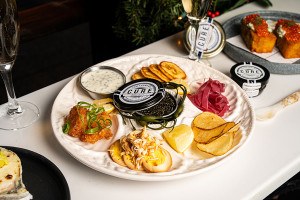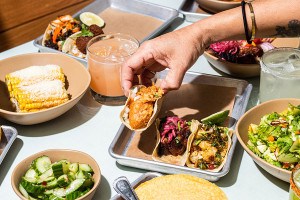Meet the Foragers Changing the Way Philly Eats
Demand for wild ingredients on restaurant menus is booming, fueling a resurgence in the art of wildcrafting.
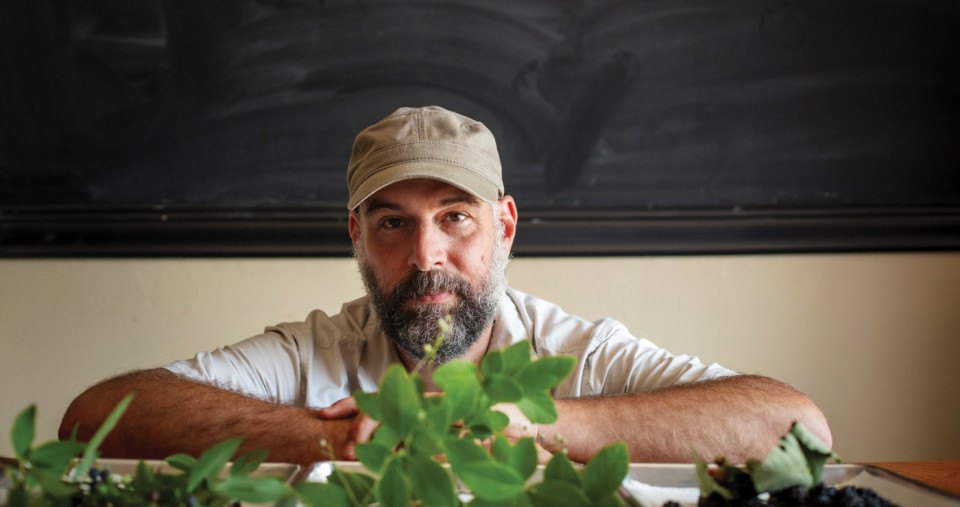
Philip Manganaro at Park Place in Merchantville / Photography by Sahar Coston-Hardy
As soon as Philip Manganaro gets out of his pickup truck, he starts rummaging through the bushes lining a gravel lot in Medford. Within a few minutes, he finds wineberries, wild grapes, and white and purple mulberries — a bounty of fruit hiding in plain sight. “These are four things so far that I can’t purchase,” he says, before moving on to the black raspberries.
Not blackberries — black raspberries. Because they’re considered too tedious to grow commercially, you can’t usually find them at the grocery store, but you can find them tucked behind the baseball field in this South Jersey park. They taste like a caricature of a red raspberry — a little exaggerated, yet familiar — but don’t pack as much tartness, giving them a smoother flavor profile. A seasonal delight cultivated through natural selection.
Manganaro is the chef and owner of Park Place in Merchantville, where he serves an ever-changing menu of wild ingredients showcasing the region’s abundance. He’ll use those wild grapes (unripe — “the birds will get to them before they fully ripen,” he explains) to make a verjus, and those black raspberries will be paired with a lard-seared quail to help bring out its wild-game essence.
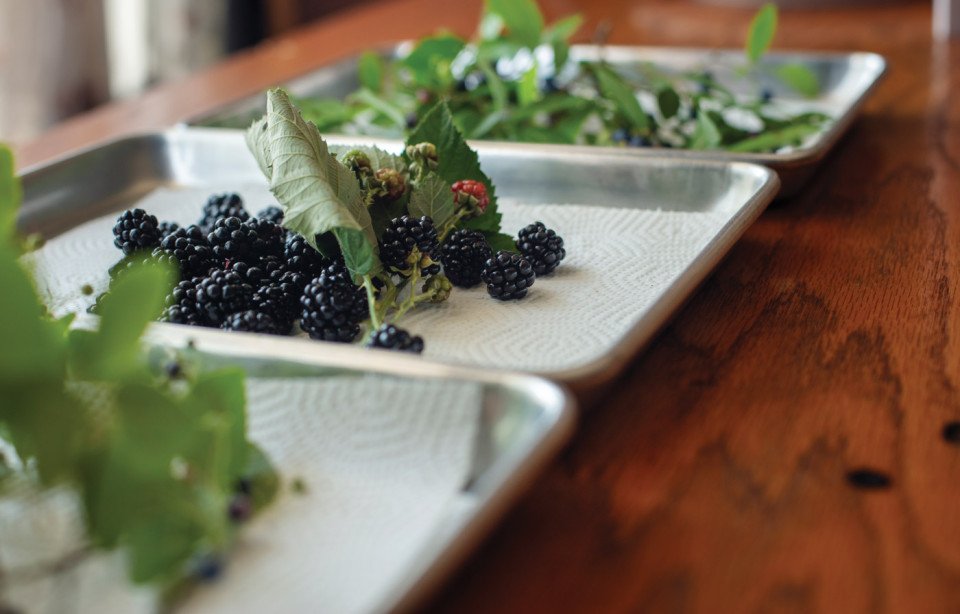
Foraged huckleberries, blackberries, and Pineland blueberries
Before starting his foraging journey eight years ago, Manganaro purchased wild ingredients from commercial suppliers: chanterelles, porcini, ramps, everything. But he decided to source as much as he could on his own after learning about the irresponsible practices used, especially among large-scale commercial foragers. “They’ll come in and clear out a whole ramp patch because they don’t care — they just want the money now,” he explains. Companies hunting for wild mushrooms, he says, will send teams of 10 to 15 people to rake up entire landscapes, leaving the land “almost like a rock quarry.” He now spends close to 30 hours a week during peak season harvesting ingredients for Park Place, 90 percent of which come from within an hour’s drive of his home in Medford.
“There’s food all over the place,” Joe Rocchi says. As a member of the Pamunkey Tribe of Virginia and a culinary educator researching food sovereignty and Indigenous foodways, he believes we can all benefit from learning more about what grows around us and how to tend to it — “If we take care of the land, the land will take care of us,” he says. It’s part of the honorable harvest, an Indigenous philosophy that governs all relationships humans have with the living world under the principle of reciprocity. Simply put: We are part of nature, so take only what you need and always give back.
Over-foraging — commercial or otherwise — is a threat to Manganaro’s livelihood. If his sources become depleted, whether by his own hands or by someone else’s, he loses a means of feeding and financially supporting himself and his 13-year-old son. It’s one of the many reasons he keeps his most valuable spots a secret and forages alone. He doesn’t want anyone coming in, disrupting the delicate balance he’s struck between himself and the land he stewards. It’s also why he tracks his inventory on a detailed spreadsheet and knows exactly how many pounds, pints, and gallon Ziploc bags he needs of every ingredient for his small restaurant, which serves 45 to 50 diners over the three days a week Park Place is open.

Black walnuts, spruce tips, and staghorn sumac
Though foraging has been a means of survival since the dawn of humanity, wild foods have been gaining mainstream attention in recent years. The pandemic lockdown drove many of us to find outdoor hobbies; TikTok influencers like Alexis Nikole are teaching millions how to identify milkweed and make pine cone jam; restaurants are leaning into hyperlocal menus to feed the public’s growing interest — the conditions for foraging to flourish are ripe.
But as demand increases, so do concerns about sustainability. It’s spurred law-bending advocacy movements, secrecy among foragers protecting their spots, debates about harvesting practices, and questions regarding what land stewardship looks like in a capitalist society where everyone’s just trying to put food on the table.
I meet Danny Childs at his South Jersey home during the summer solstice heat wave. The air is heavy with a sweet, gingery aroma from a pot of sassafras roots boiling for a batch of root beer reminiscent of his great-grandfather’s recipe, the main ingredient of which is banned by the FDA for containing safrole. In 1960, a study showed that ingesting high quantities of safrole contributed to liver cancer in rats, but a more recent study failed to prove the same effects in humans. According to Childs, the ban is an effort to demonize sassafras because it can be used to make the party drug MDMA. He serves sassafras as a way to advocate for its legalization. “It’s a form of resistance, saying that this is in fact totally safe in moderation, the same way sugar, alcohol, or smoked meats are,” he says.

Danny Childs making a walnut old fashioned with nocino
Before becoming a beverage consultant, Childs was an ethnobotanist, studying how Indigenous populations in South America use plants for medicine. The dysentery-curing cocktails of herbal tinctures and wild-fermented brews made from corn and yuca he encountered in his fieldwork left a lasting impression. When he returned to New Jersey, he started exploring the local flora and experimenting with his foraged finds to craft botanical cocktails he served during his time as the bar manager of Farm & Fisherman in Cherry Hill. These recipes are compiled in his recent James Beard Award-winning cocktail book, Slow Drinks: A Field Guide to Foraging and Fermenting Seasonal Sodas, Botanical Cocktails, Homemade Wines, and More. Through his research, he realized that foraging can also be a powerful platform to connect others to social and ecological issues.
By eating it, sharing it, talking about it, introducing other people to it, you’re raising awareness about it.” — Danny Childs
Behind a dumpster in a Camden County parking lot, Childs shows me his secret butternut tree. Also known as the American white walnut, this tree is listed as “critically imperiled” by the New Jersey Department of Environmental Protection — the population is declining due to butternut canker, a fungal blight.
Foraging laws vary from state to state and come with vague caveats depending on whether you’re on state or public lands (you can pretty much do whatever you want on private land if you’re the owner or have the owner’s permission). In Pennsylvania state parks and forests, gathering edible plants is limited to personal consumption, as long as the plants aren’t “threatened, endangered, rare, or vulnerable.” On New Jersey state lands it’s outright prohibited, unless you have obtained permission from the state park service. But we’re not on state land. We’re in the liminal green space between a parking lot and a highway. And as far as rare plants go, there are no statewide protections.
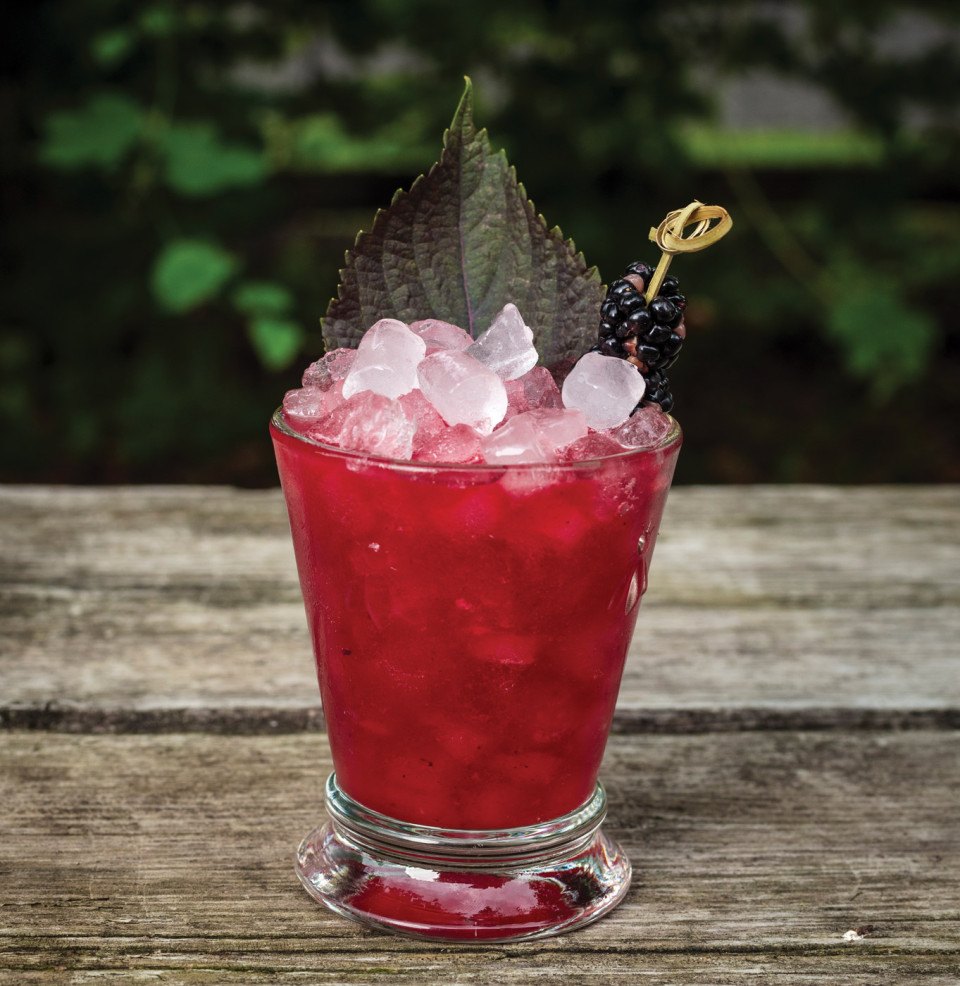
Blackberry smash cocktail
Childs doesn’t find any butternuts this time, but in the past, he’s picked a few from this tree to make nocino, the earthy and somewhat bitter Italian liqueur. It has a centuries-long history involving Roman virgins who celebrated the summer solstice by collecting unripened walnuts, cutting them in half, and submerging them in alcohol for six months to be enjoyed at the winter solstice. Because the tree is endangered, Childs stretches the nocino as much as he can, using only a dash to an ounce when sharing the butternut’s story through drinks like his walnut old-fashioned. The butternut is part of Slow Food USA’s Ark of Taste, a catalog of foods facing extinction that promotes innovative ways to keep at-risk ingredients in production and on the plate — on a case-by-case basis, of course. “By eating it, sharing it, talking about it, introducing other people to it, you’re raising awareness about it in the process and raising people’s appreciation of it,” Childs says.
Omar Tate and Cybille St. Aude-Tate, co-owners and chefs of Honeysuckle Provisions in West Philadelphia, are ecologically minded in their foraging as well, but take a different approach. They focus more on removing invasive species in West Philadelphia and East Oak Lane to help other plants thrive, all while championing Black traditions and foodways. Their UNTITLED dinner series has featured Japanese knotweed stuffed with a scallop, and trifoliate orange farce smothered in pickled oyster foam and garnished with fermented wild chives.
By reclaiming and reengaging with the practice of foraging in the present, we are able to honor a lost connection while also building new ties and new ideas to share with others.” — Omar Tate
“We believe that the urbanization of our society over the last two centuries has shifted our relationship to nature from one of necessity to a shallow one of convenience,” Tate says. After the Civil War, anti-trespassing laws targeted Black foragers to make them reliant on the farms from which they had just been freed. Then, during the 20th century’s Great Migration, six million Black Americans fled the Jim Crow laws of the South for cities like New York, Chicago, and Philadelphia, and in doing so “shed the intimacy they once shared with land,” he says. “By reclaiming and reengaging with the practice of foraging in the present, we are able to honor a lost connection while also building new ties and new ideas to share with others.”
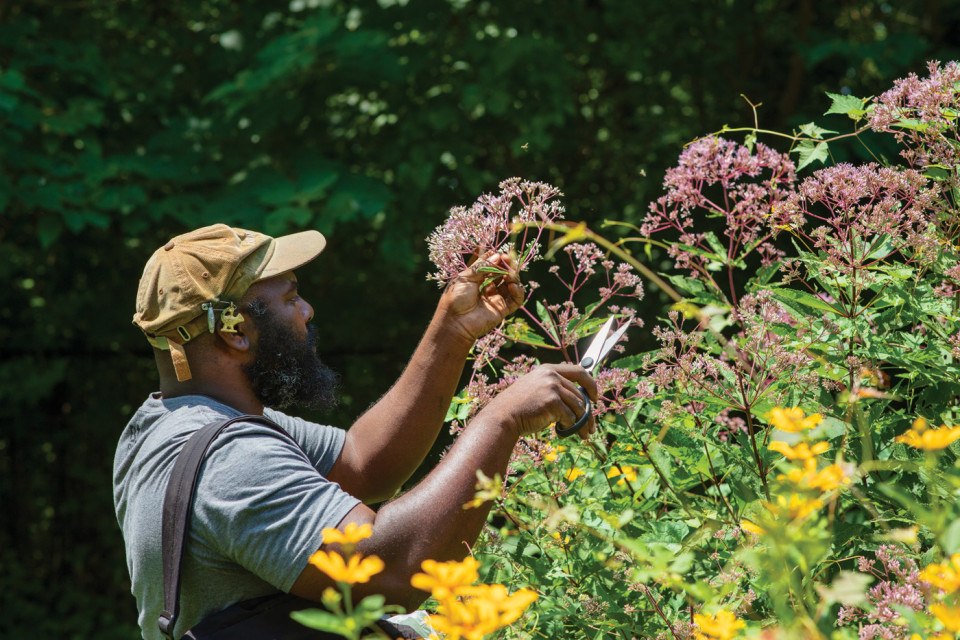
Omar Tate harvesting trumpet weed / Photography by Sahar Coston-Hardy
Lady Danni Morinich, a Black forager, herbalist, and plant educator living in South Philly, also believes that invasives and “the plants formerly known as weeds,” as she calls them, can be an incredible source of food, especially for those living in underserved communities. “This could be a free green vegetable that’s offering you so much nutrition that most people are just ignoring,” she says, emphasizing the potential of these underappreciated weeds.
But edibles like mugwort, plantain, cleavers, and even Japanese knotweed aren’t as sexy in the burgeoning foraged foods market — nor are they as trendy as her biggest bugbear, ramps. “Everybody and their brother wants ramps,” she says, “and the thing that pisses me off is that we have an influx of garlic mustard,” which is invasive and has many of the same pungent flavor notes. But it’s harder to market, she adds, especially now that ramps are in vogue.
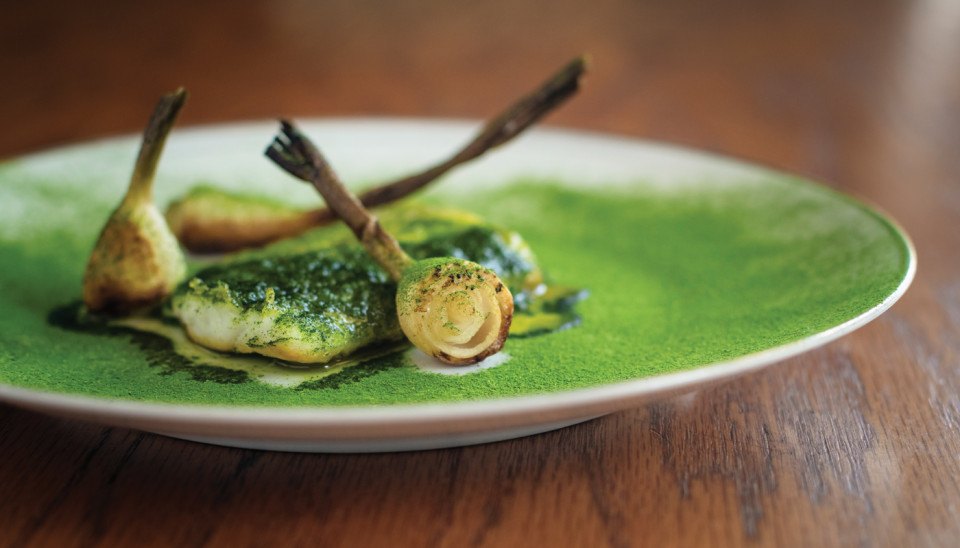
Wild Spanish sea bass with slow-roasted ramp bulbs, green lard, and ramp-greens dust at Park Place
In the early ’90s, Martha Stewart Living published a recipe celebrating the oniony, garlicky wild leek, sparking a ramp rush. Since then, culinary circles have been feeding the frenzy, adding them to seasonal menus and selling them at markets and farm stands, making ramps as popular as they are polarizing.
Blanketing forest floors across eastern North America, the contentious allium reproduces clonally and by seed, but according to the USDA, takes five to seven years to mature. Unlike harvesting fruit from a tree that stays behind to provide yield after yield, picking ramps means you’re either damaging the plant or removing it entirely from its habitat. Their slow growth paired with the rising demand has foragers concerned that we’re harvesting them faster than they can grow.
From casual pickers learning about what grows behind the Fairmount Water Works to chefs on the hunt in Ridley Creek State Park, everyone has a different way to mitigate the issue. Some foragers don’t pick any or take just one leaf. Some pick the whole bulb, but warn that it shouldn’t go to waste. The Tates and Childs pick only the leaves; Manganaro picks the whole bulb and says people get pretty heated about it. He picks 100 pounds of late-season ramps per year to make powders and purees and serves them pickled and roasted. He harvests one ramp in a cluster and then moves on to the next in multiple patches. He leaves spots he feels are being over-harvested, and even plants bulbs to start new patches: “I want to be able to go back there in 10 to 15 years and get more.”
Sarah Nilson, an assistant professor of biology at Penn State, and Eric Burkhart, an ethnobotanist and teaching professor at Penn State, have been studying ramps — their biology and the changing culture around them — for the past seven years. Their research suggests that careless harvesting practices like taking ramps too early and taking too many from a single patch can contribute to unsustainable exploitation. “But we also agree that ramps are a culturally important plant, and we want to preserve the activity of foraging,” says Nilson.
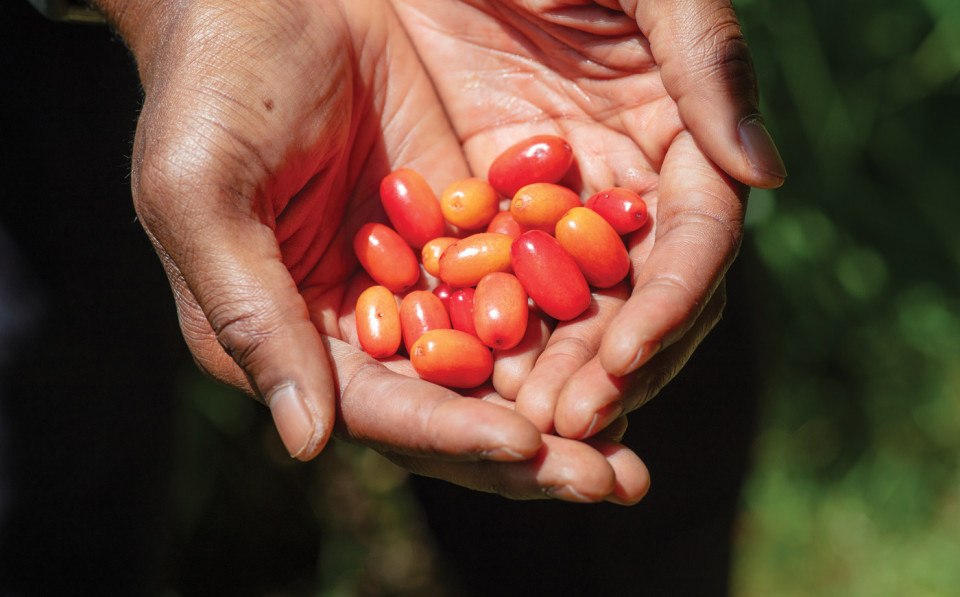
Foraged Cornelian cherries
Like every living thing balancing its weight on the delicately calibrated mobile that is our ecosystem, ramps have their place. They aren’t considered a biological keystone plant, as most animals don’t eat them due to the sulfuric compounds that humans find so tasty. But they are classified as a cultural keystone plant for being a source of food and financial stability for generations of people, especially in Pennsylvania’s Appalachian region, where Burkhart is from.
For now, Burkhart says he doesn’t think the sky is falling. He and Nilson are more concerned about educating without shaming and offering proactive things we can do before things get out of control. They see this as an opportunity to empower foragers to put systems in place to harvest more sustainably. Burkhart advocates for forest farming, the cultivation of edible and medicinal crops under a tree canopy. Rocchi says this is reminiscent of Indigenous practices informed by thousands of years of carefully planned polycultures and companion planting. “[Native Americans] basically landscaped the world over here to feed themselves,” Rocchi explains.
Nilson and Burkhart say people can take the leaves and the bulbs too, adding that taking just a leaf isn’t de facto sustainable — it still robs the plant of what it needs to make food. “But they need to be trained and they need to be educated and educate themselves around how to do that sustainably,” Burkhart says.
A recent report Nilson and Burkhart published found that if foragers wait until later in the season, when the bulb swells into a teardrop shape, the ramps’ total weight and bulb weight increase “250 percent and 400 percent, respectively, between early season and late season stages.” To promote more sustainable foraging, they’ve coined the slogan “Fewer ramps per pound means more ramps left in the ground.” They also say the season doesn’t end in the spring. Be a land steward. Go back to your patches, spread the seeds, and plant bulbs in different patches to increase their biodiversity. Reciprocity can make a difference.
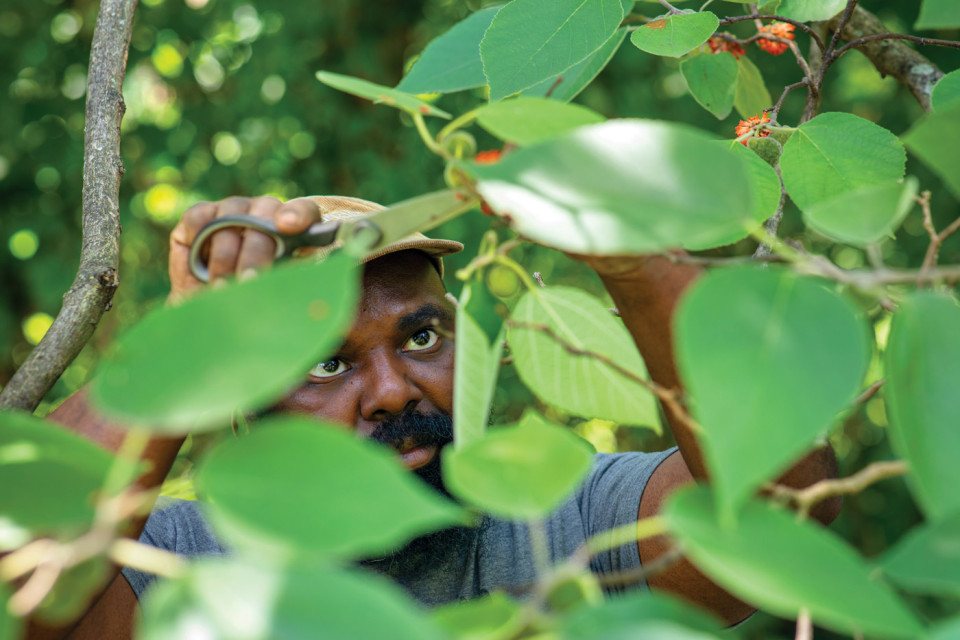
Omar Tate of Honeysuckle Provisions harvesting paper mulberry fruit in West Philadelphia
As for Manganaro and his harvesting practices, Burkhart and Nilson don’t want to pass judgment. “It seems that this person cares, is educating themself, and is trying their best to sustain the population,” says Burkhart. “That’s all one can hope for.”
Every forager’s path is different. They diverge in parking lots and dense forests. They come to a crossroads between outlawed root beers, endangered liqueurs, controversial crops, and feasts made with invasives. But they converge on issues like habitat loss, climate change, and centuries of laws limiting our access to the land, and they share the common ground of hope for foraging’s abundant future. It all depends on how we balance culinary trends with sustainability.
The road ahead isn’t straightforward. It’s thorny, and it’s easy to get caught in the weeds. But if we educate ourselves, follow the honorable harvest, and work to sustain what sustains us, perhaps we’ll see the forest through the trees.
Published as “Foraging Ahead” in the September issue of Philadelphia magazine.
